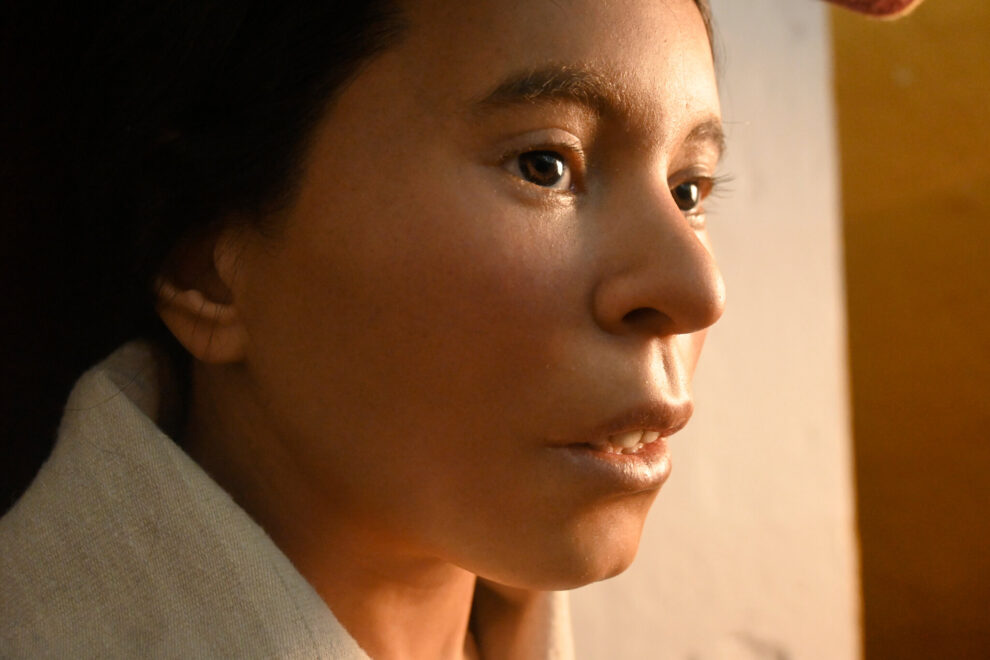A team of scientists worked with an archaeologist who specializes in facial reconstructions to create the silicone likeness of a girl whose remains were found on a volcano in 1995.
A famous mummy of a young Inca girl who was sacrificed in a religious ritual more than 500 years ago on a mountaintop in Peru now has a face.
A silicone bust depicts the Inca teenager, who has been called Juanita and the Maiden of Ampato, after the snowy mountain where she was found, with dark eyes, high cheekbones and tanned skin. The model was revealed last week at a ceremony at the Andean Sanctuaries Museum of the Catholic University of Santa Maria in Arequipa, Peru, where it is on display to the public.
A team of Polish and Peruvian scientists worked with a Swedish archaeologist who specializes in facial reconstructions to create the bust, based on the frozen Inca girl’s body.
“It’s a reconstruction, muscle by muscle,” Franz Grupp Castelo, a coordinator of Andean sanctuaries for the museum, said at a news conference, describing the finished product as an “impressive work.”
In 1995, a team of archaeologists led by Johan Reinhard ascended about 20,000 feet up the snowy Ampato volcano in the Peruvian province of Caylloma, where they discovered a frozen body swaddled in cloth that had been buried there 500 years ago, the university said. The well-preserved remains of the girl, who was found in a sitting position, were naturally mummified in the freezing environment and had been entombed in ice.
Uncovering the Past, One Discovery at a Time
- From Hunted to Hunter: A new study is the first to show that the Neanderthals, who until recently were judged by scientists too helpless to hunt on their own, intentionally stalked large beasts of prey and apex predators.
- Ancient Footprints: A 2021 paper concluded that humans could have first set foot in North America as early as 21,000 to 23,000 years ago. A new study adds to the evidence for those surprisingly ancient dates.
- Emerging From Ice: As the earth warms, glacial archaeologists are in a race against time to preserve objects before they are destroyed by the elements. Recent field work yielded a 3,000-year-old arrow.
- Ancient Logs: Scientists have unearthed logs in Africa that are nearly a half-million years old, the remnants of large wooden structures crafted by our early ancestors. The discovery drastically pushes back the historical record of structural woodworking.
Mr. Reinhard said he had always imagined what the girl’s face looked like.
“It was a shock when I saw, for the first time, Juanita’s face,” Dr. Reinhard said at the unveiling ceremony.
He added: “I never thought I would see her face when she was alive. Now 28 years later, it has become a reality.”
The girl is believed to have been 13 to 15 years old when she died. Scientists at Johns Hopkins University in Baltimore concluded after an examination that she was sacrificed at the top of the volcano as an offering to the gods. Researchers said she had most likely received a blow to the right part of the occipital bone, in the back of the skull, which would have killed her instantly.
The museum said that the silicone bust of her face was made based on digital images and scans of her skull; CT scans of her body, which is stored in a chamber in the museum that is chilled to negative 20 degrees Celsius; and analysis of her DNA, ethnological characteristics, age and complexion.
Dagmara Socha, an archaeologist at the Center for Andean Studies at the University of Warsaw, who also attended the ceremony, said that the reconstruction of the girl’s face “was very emotional” for her.
She said the face gives a “hyper, hyper-realistic impression of looking at the living person.”
The CT scan, she added, was “crucial to reconstructing the thickness of soft tissues” for the model.
“A well-made reconstruction allows us to show the people who were behind the story we want to tell,” she said.
Oscar Nilsson, a Swedish archaeologist and sculptor, was the specialist who helped turn the scans of the mummy into the lifelike facial reconstruction of the Inca girl. Dr. Socha said that the face was first modeled in clay and then cast in silicone.
Dr. Socha noted that the reconstruction process took around half a year and that Dr. Nilsson spent about 400 hours working on the model.
Scientists from the University of Warsaw created an exhibition at the Andean Sanctuaries Museum of the Catholic University of Santa María where the bust will be on view to visitors.
Artifacts and ceramic objects decorated with geometric figures that were found next to the girl’s body will also be on display.
Those objects, Dr. Reinhard said, have “helped us better understand her life and the Inca culture,” he said.
Source : The New York Times











